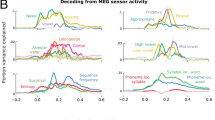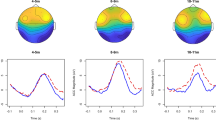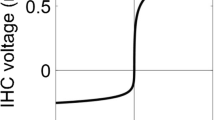Abstract
A unified connectionist model of the perceptual magnet effect (the perceptual warping of vowels) is proposed, and relies on the concept of population coding in neural maps. Unlike what has been often stated, we claim that the imprecision of the classical “sum of vectors” coding/decoding scheme is not a drawback and can account for psychological observations. Furthermore, we show that coupling these neural maps allows the formation of vowel systems, which are shared symbolic systems, from initially continuous and uniform perception and production. This has important consequences for existing theories of phonetics.
Access this chapter
Tax calculation will be finalised at checkout
Purchases are for personal use only
Preview
Unable to display preview. Download preview PDF.
Similar content being viewed by others
References
Abbot L., Salinas E. (1994) Vector reconstruction from firing rates, Journal of computational Neuroscience, 1, 89–116.
Anderson J., Silverstein, Ritz, Jons (1977) Distinctive features, categorical perception and probability learning: some applications of a neural model, Psychologycal Review, 84, 413–451.
Watson G.S. (1964) Smooth regression analysis, Sankhya: The Indian Journal of Statistics. Series A, 26 359–372.
Reggia J.A., D’Autrechy C.L., Sutton G.G., Weinrich M. (1992) A competitive distribution theory of neocortical dynamics, Neural Computation, 4, 287–317.
R.I. Damper and S.R. Harnad (2000) Neural network modeling of categorical perception. Perception and Psychophysics, 62 p. 843–867.
Georgopoulos, Kettner, Schwartz (1988), Primate motor cortex and free arm movement to visual targets in three-dimensional space. II. Coding of the direction of movement by a neuronal population. Journal of Neurosciences, 8, pp. 2928–2937.
Guenther and Gjaja (1996) Magnet effect and neural maps, Journal of the Acoustical Society of America, vol. 100, pp. 1111–1121.
Kuhl, Williams, Lacerda, Stevens, Lindblom (1992), Linguistic experience alters phonetic perception in infants by 6 months of age. Science, 255, pp. 606–608.
Kuhl (2000) Language, mind and brain: experience alters perception, The New Cognitive Neurosciences, M. Gazzaniga (ed.), The MIT Press.
Steels, L. (1997a) The synthetic modeling of language origins. Evolution of Communication, 1(1):1–35.
Steels L., Oudeyer P-y. (2000) The cultural evolution of phonological constraints in phonology, in Bedau, McCaskill, Packard and Rasmussen (eds.), Proceedings of the 7th International Conference on Artificial Life, pp. 382–391, MIT Press.
Archangeli and Langendoen (1997), Optimality theory, an overview, Blackwell Publishers.
Author information
Authors and Affiliations
Editor information
Editors and Affiliations
Rights and permissions
Copyright information
© 2001 Springer-Verlag Berlin Heidelberg
About this paper
Cite this paper
Oudeyer, Py. (2001). Coupled Neural Maps for the Origins of Vowel Systems. In: Dorffner, G., Bischof, H., Hornik, K. (eds) Artificial Neural Networks — ICANN 2001. ICANN 2001. Lecture Notes in Computer Science, vol 2130. Springer, Berlin, Heidelberg. https://doi.org/10.1007/3-540-44668-0_163
Download citation
DOI: https://doi.org/10.1007/3-540-44668-0_163
Published:
Publisher Name: Springer, Berlin, Heidelberg
Print ISBN: 978-3-540-42486-4
Online ISBN: 978-3-540-44668-2
eBook Packages: Springer Book Archive




